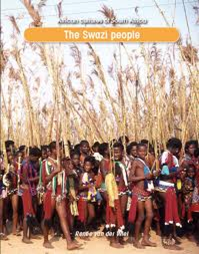The Swazi People by R. Van der Wiel
DOI:
https://doi.org/10.20361/G2QP5ZAbstract
Van der Wiel, Renée. The Swazi People. Gallo Manor, South Africa: Awareness Publishing Group, 2012. Print.
South Africa describes itself as “one rainbow nation going forward”, but within that rainbow there are eleven indigenous South African peoples. The Swazi People is one of eleven volumes in the African Cultures of South Africa series, which presents the cultures for readers at the upper elementary level. The other volumes include the cultures of The Khoikhoi, The Ndebele, The North Sotho, The San, The South Sotho, The Tsonga-Shangaan, The Tswana, The Venda, The Xhosa, and The Zulu.
In The Swazi People, Renée Van der Wiel describes their arts and crafts, beliefs, clothes, history, houses, language, leaders, marriage, music and dance, recipes, and way of life. The book incorporates many Swazi words, which are listed in the glossary at the back of the book. For example, mahiya (cotton cloth), gogo (grandmother) and lobola (marriage gift, usually cattle) are all listed in the glossary.
This volume is attractively produced and brightly coloured. It opens with a full-page map of South Africa that shows the historical movements of the Swazi people and highlights their homelands. Text and images are presented on alternate pages. The professional quality images are usually full-page and are either historical black and white photos or modern colour photos of Swazi people engaged in traditional activities. There is also an index, which improves the book's usefulness as an elementary research text.
The text is written in age-appropriate language and deals with the subjects in sufficient detail that as an adult, I was able to learn from it. In general, the tone is objective and non-judgemental. For example, "[i]n 1973, King Sobhuzall and the Imbokoduo National Movement stopped all other political parties from taking part in elections in Swaziland. (…) After only five years of being a democracy, Swaziland became a country ruled by a king." Where there is bias present, it is more in the form of presenting the Swazi point of view: "But the Boers did not care about looking after the Swazi people – all they wanted was to get through to the sea without having to travel through British territory.".
This sturdily bound volume is an excellent work and is highly recommended for public and elementary school libraries.
Highly recommended: 4 stars out of 4
Reviewer: Sandy Campbell
Sandy is a Health Sciences Librarian at the University of Alberta, who has written hundreds of book reviews across many disciplines. Sandy thinks that sharing books with children is one of the greatest gifts anyone can give.

Published
How to Cite
Issue
Section
License
Authors who publish with this journal agree to the following terms:
- Authors retain copyright and grant the journal right of first publication with the work simultaneously licensed under a Creative Commons Attribution License that allows others to share the work with an acknowledgement of the work's authorship and initial publication in this journal.
- Authors are able to enter into separate, additional contractual arrangements for the non-exclusive distribution of the journal's published version of the work (e.g., post it to an institutional repository or publish it in a book), with an acknowledgement of its initial publication in this journal.
- Authors are permitted and encouraged to post their work online (e.g., in institutional repositories or on their website) prior to and during the submission process, as it can lead to productive exchanges, as well as earlier and greater citation of published work (See The Effect of Open Access).






